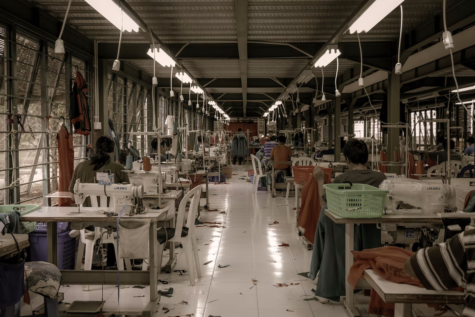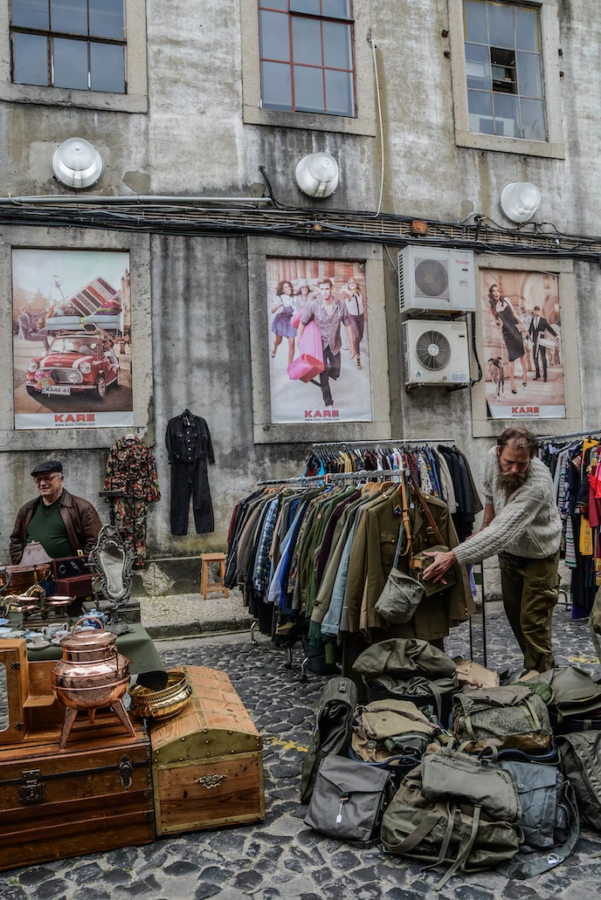How Problematic is the New Demographic of Thrifting?
Although thrifting has good intentions in fighting fast fashion and environmental issues, it poses problems for those who see thrifting as one of their only options for clothing.
Low income communities can take advantage of the affordable prices that thrift stores offer for necessities such as jackets and bags.
The environmental damage and questionable labor practices of fast fashion brands are well known problems. As an alternative, many people have turned to thrifting as a way to shop for stylish pieces at low prices. The trend has reached mainstream media, with popular influencers frequenting their local thrift stores to post “thrift hauls,” showcasing their trendy finds that were bought on a budget. Despite the positive effects of thrifting, the increasing number of thrifters may result in wealthier demographics taking away necessary resources that lower-income communities need to survive.
An example of a necessary resource would be winter coats; they become an essential during freezing temperatures, yet high-quality coats from brands like Uniqlo or North Face can range from $80 to $500, even at a discount.
At some Goodwill outlets, this issue is mitigated by allowing shoppers to pay for items by the pound, which significantly reduces the original prices of higher-end items. With this in mind, it’s no surprise that some of the most prominent thrift stores in New York City, such as L Train Vintage and Urban Jungle, are located in Bushwick and East Williamsburg, where the NYU Furman Center reports that in 2019, 20.7% and 20.1% of residents lived in poverty, respectively. These individuals are the most in need of the resources that thrift stores provide. However, it’s startling to see so many middle to high income consumers in these shops, buying necessities that they could very well afford at full price.
Additionally, a study by El Vaquero reports that prices at Goodwill shops have tripled in recent years. A Goodwill valuation guide from 2010 shows their goods valued at flat rates of $4.00 for shirts, $6.00 for jeans, and $6.00 for shoes. In a 2020 valuation guide, the costs range from $2–12.00 for women’s shirts, $4–21.00 for jeans, and $4–9.00 for tennis shoes. This drastic increase in price can be attributed to the sudden influx of thrifters.
Because fast fashion is mass-produced, their prices are similar, if not cheaper, than the prices at thrift stores; Fashionnova jeans cost around $15.00, Shein leggings are priced at $5.00, and Forever 21 tank tops go as low as $2.79 during sales. Low-income individuals will feel more inclined to shop for fast fashion brands if they see that it’s more affordable.

The new demographic of thrifting has also spread to online secondhand stores such as ThredUp, Poshmark, and Depop. Despite their original intent to make fashion more attainable through digital means, resellers fill the listings with items that are sold for multiple times the original price. For instance, shoppers can find a thrifted Hello Kitty bookbag being sold for over $40.00.
One might argue that sellers are allowed to price their products at what they deem the market will bear, whether it is dependent on the item’s trendiness, rarity, or personal value. However, this also raises the question of morality and the extent to which resellers are willing to go to in order to profit off of something that was meant to be affordable and accessible to all. Nonetheless, resellers are still selling something that they own, and they should have the freedom to price a piece at whatever they deem as acceptable. It is very well possible that it may be their main or only source of income, as everyone may have a different motive for why they’re reselling.
Despite the problems that have arisen with the popularity of thrifting, its positive impact on our environment and individuality cannot be overlooked. Thrifting was once looked down upon as something “degrading” and “dirty,” but because of its popularity in mainstream media, the stigma has been lessened. Garage reports how recent trends in high fashion have been revolving around a “labor-influenced” style, meant to emulate the authenticity of the working class: firefighter uniforms from Calvin Klein, DHL T-shirts from Vetemonts, even ID badges from Prada. Though some see this style as the appropriation of the working class, it undeniably shows the evolution of fashion.
Moreover, thrift stores also don’t typically sell one genre of clothing, meaning that shoppers can experiment with different styles without having to worry about committing too much money. Bryan Jee ’23 of Bayside High School thrifts every few weeks, and he has found some of his favorite pieces in Goodwill bins. “I think it’s a very cheap and sustainable way of buying clothes, and it also enables me to express myself.”
The biggest positive to thrifting is that it is one of the biggest forces against fast fashion. When consumers shop secondhand, they are reducing the chemical pollution produced when creating new clothing. Victoria Kim ’23 of Bronx Science agrees, stating, “You’re able to get unique pieces for cheap, in addition to the fact that it reduces your carbon footprint.” It is important to attribute thrifting to the successes we’ve made in sustainability and individuality in today’s society.
Ultimately, thrifting isn’t exclusive to a specific group, and everyone should have the choice to shop secondhand. However, there are many other ways to sustainably shop. One way is supporting eco-friendly brands; clothing companies like Patagonia use recycled materials in 98% of their line, and the company’s founder, Yvon Chouinard, has donated the entire company’s non-voting stock, valued at $3 billion, to a collective that will use profits that are not reinvested to fight climate change.
Another method is shopping locally. By purchasing items that are manufactured near your area, you lessen the need for products to be shipped over long distances with trucks and airplanes that emit greenhouse gases. There are endless ways for consumers to live a more sustainable lifestyle.
What is important is to recognize one’s financial privilege in order to ensure those who don’t have alternatives to thrifting can purchase what they need.
Despite the positive effects of thrifting, the increasing number of thrifters may result in wealthier demographics taking away necessary resources that lower-income communities need to survive.
Chelsea Li is an Editorial Editor for 'The Science Survey' and reviews and edits articles published in this section prior to publication. She finds that...

